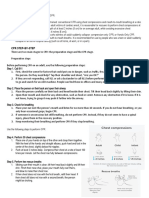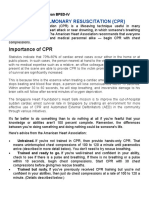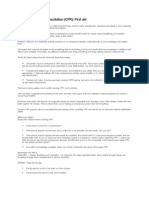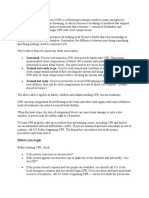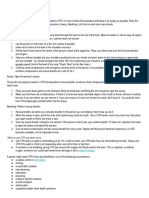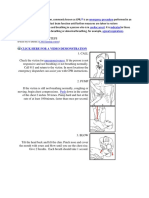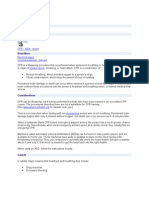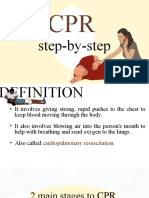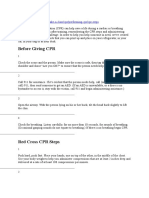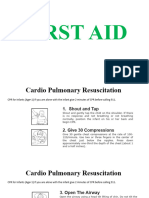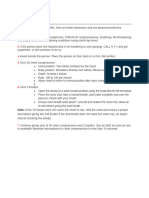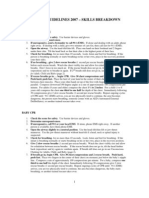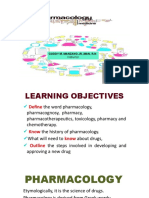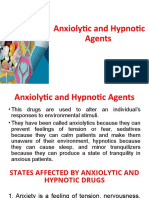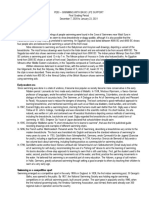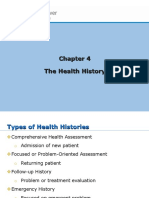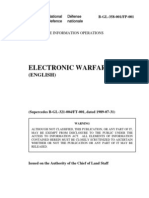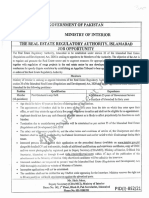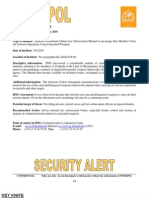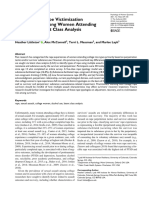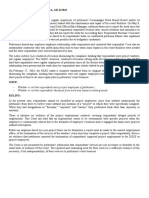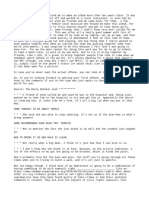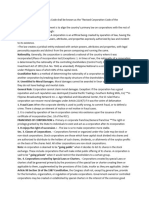CPR 2
CPR 2
Uploaded by
Moxie MacadoCopyright:
Available Formats
CPR 2
CPR 2
Uploaded by
Moxie MacadoOriginal Title
Copyright
Available Formats
Share this document
Did you find this document useful?
Is this content inappropriate?
Copyright:
Available Formats
CPR 2
CPR 2
Uploaded by
Moxie MacadoCopyright:
Available Formats
How is CPR Performed?
There are two commonly known versions of CPR:
1. For healthcare providers and those trained: conventional CPR using chest compressions and mouth-to-mouth breathing at a ratio
of 30:2 compressions-to-breaths. In adult victims of cardiac arrest, it is reasonable for rescuers to perform chest compressions at
a rate of 100 to 120/min and to a depth of at least 2 inches (5 cm) for an average adult, while avoiding excessive chest
compression depths (greater than 2.4 inches [6 cm]).
2. For the general public or bystanders who witness an adult suddenly collapse: compression-only CPR, or Hands-Only CPR.
Hands-Only CPR is CPR without mouth-to-mouth breaths. It is recommended for use by people who see a teen or adult suddenly
collapse in an out-of-hospital setting (such as at home, at work, or in a park).
CPR STEP-BY-STEP
There are two main stages to CPR: the preparation stage and the CPR stage.
Preparation steps
Before performing CPR on an adult, use the following preparation steps:
Step 1. Call 911
1. First, check the scene for factors that could put you in danger, such as traffic, fire, or falling masonry. Next, check
the person. Do they need help? Tap their shoulder and shout, “Are you OK?”
2. If they are not responding, call 911 or ask a bystander to call 911 before performing CPR. If possible, ask a bystander
to go and search for an AED machine. People can find these in offices and many other public buildings.
Step 2. Place the person on their back and open their airway
1. Place the person carefully on their back and kneel beside their chest. Tilt their head back slightly by lifting their chin.
2. Open their mouth and check for any obstruction, such as food or vomit. Remove any obstruction if it is loose. If it is
not loose, trying to grasp it may push it farther into the airway.
Step 3. Check for breathing
1. Place your ear next the person’s mouth and listen for no more than 10 seconds. If you do not hear breathing, or you
only hear occasional gasps, begin CPR.
2. If someone is unconscious but still breathing, do not perform CPR. Instead, if they do not seem to have a spinal
injury, place them in the recovery position.
3. Keep monitoring their breathing and perform CPR if they stop breathing.
Use the following steps to perform CPR:
Step 4. Perform 30 chest compressions
1. Place one of your hands on top of the other and clasp them together.
With the heel of the hands and straight elbows, push hard and fast in the
center of the chest, slightly below the nipples.
2. Push at least 2 inches deep. Compress their chest at a rate of least 100
times per minute. Let the chest rise fully between compressions.
Step 5. Perform two rescue breaths
1. Making sure their mouth is clear, tilt their head back slightly and lift their
chin. Pinch their nose shut, place your mouth fully over theirs,
and blow to make their chest rise.
2. If their chest does not rise with the first breath, retilt their head. If
their chest still does not rise with a second breath, the person
might be choking.
Step 6. Repeat
1. Repeat the cycle of 30 chest compressions and two rescue breaths until the person starts breathing or help arrives. If an AED
arrives, carry on performing CPR until the machine is set up and ready to use.
You might also like
- Law School Remedies Cheat SheetDocument2 pagesLaw School Remedies Cheat SheetMSN21987100% (3)
- Adult Child Infant CPR StepsDocument7 pagesAdult Child Infant CPR StepsCathy GuerreroNo ratings yet
- CPR Video ScriptDocument13 pagesCPR Video ScriptMerryll MeridorNo ratings yet
- CPR 2Document2 pagesCPR 2Moxie MacadoNo ratings yet
- CPR AssignmentDocument3 pagesCPR AssignmentMUHAMAD FADZLI BIN SUDIN MoeNo ratings yet
- Importance of CPRDocument6 pagesImportance of CPRKatherine Canisguin AlvarecoNo ratings yet
- What Is First Aid?: Before You BeginDocument3 pagesWhat Is First Aid?: Before You Beginfatima fontanillaNo ratings yet
- Emergency Treatment (CPR)Document6 pagesEmergency Treatment (CPR)Babar Photo stateNo ratings yet
- Cardiopulmonary Resuscitation (CPR) : First Aid: UntrainedDocument7 pagesCardiopulmonary Resuscitation (CPR) : First Aid: UntrainedCharles Dominique Nikko LabraNo ratings yet
- Cardiopulmonary ResuscitationDocument3 pagesCardiopulmonary ResuscitationMerfy KatsaNo ratings yet
- Cardiopulmonary Resuscitation (CPR) : First AidDocument5 pagesCardiopulmonary Resuscitation (CPR) : First AidJules RyanNo ratings yet
- Cardiopulmonary ResuscitationDocument25 pagesCardiopulmonary Resuscitationahmadslayman1No ratings yet
- CPRDocument9 pagesCPRHervina MahmudNo ratings yet
- Cardio-Pulmonary Resuscitation: Dr. Sebastian ValceaDocument16 pagesCardio-Pulmonary Resuscitation: Dr. Sebastian ValceaAna MariaNo ratings yet
- Pertolongan Pertama (CPR)Document4 pagesPertolongan Pertama (CPR)odjakmNo ratings yet
- Before You Begin: - (Teori Nelpon Sama Rara)Document2 pagesBefore You Begin: - (Teori Nelpon Sama Rara)UteNo ratings yet
- CPR&EARDocument2 pagesCPR&EARKenny Yeoh Kai XiangNo ratings yet
- 3.1 Introduction To First Aid and CPRDocument5 pages3.1 Introduction To First Aid and CPRPriyanshu BalaniNo ratings yet
- First Aid For No Breathing: 1. Check Breathing by Tilting Their Head Back and Looking and Feeling For BreathsDocument9 pagesFirst Aid For No Breathing: 1. Check Breathing by Tilting Their Head Back and Looking and Feeling For BreathsRenzdy MejillaNo ratings yet
- Under 8 Minutes: When To Use CPR and When Not ToDocument2 pagesUnder 8 Minutes: When To Use CPR and When Not ToMoxie MacadoNo ratings yet
- Under 8 Minutes: When To Use CPR and When Not ToDocument2 pagesUnder 8 Minutes: When To Use CPR and When Not ToMoxie MacadoNo ratings yet
- CPR 1Document14 pagesCPR 1brimaalhaji0No ratings yet
- Click Here For A Video Demonstration: UnresponsivenessDocument3 pagesClick Here For A Video Demonstration: UnresponsivenessJnana YumnaNo ratings yet
- Group 15: Benito, Germaine Ann A. Wingie, John Icon: Cardiopulmonary Resuscitation (CPR)Document7 pagesGroup 15: Benito, Germaine Ann A. Wingie, John Icon: Cardiopulmonary Resuscitation (CPR)capawaymayNo ratings yet
- Cardio-Pulmonary ResuscitationDocument6 pagesCardio-Pulmonary Resuscitationrupali gahalian100% (4)
- Untrained. If You're Not Trained in CPR, Then Provide Hands-Only CPR. ThatDocument12 pagesUntrained. If You're Not Trained in CPR, Then Provide Hands-Only CPR. ThatClaire DayritNo ratings yet
- CPR PresentationDocument22 pagesCPR PresentationAlan HabalNo ratings yet
- CPRDocument2 pagesCPRchaudharitrushar007No ratings yet
- Adult One - Rescuer CPR - RoniDocument14 pagesAdult One - Rescuer CPR - RonirinaNo ratings yet
- First Aid Referat EnglezaDocument3 pagesFirst Aid Referat EnglezalbordeanuNo ratings yet
- Cardio Pulmonary ResuscitationDocument35 pagesCardio Pulmonary ResuscitationAzihl DalionesNo ratings yet
- CPR For Children and Infants: Cardiopulmonary ResuscitationDocument2 pagesCPR For Children and Infants: Cardiopulmonary Resuscitationjanna mae patriarcaNo ratings yet
- Blue and Yellow Playful Doodle Digital Brainstorm Presentation - 20240504 - 103438 - 0000Document8 pagesBlue and Yellow Playful Doodle Digital Brainstorm Presentation - 20240504 - 103438 - 0000CHRIS MARLOWE YAMBAONo ratings yet
- Cardiopulmonary Resuscitation (CPR)Document15 pagesCardiopulmonary Resuscitation (CPR)fkrishna445No ratings yet
- CPR - Adult: Medlineplus TopicsDocument16 pagesCPR - Adult: Medlineplus TopicsNorsazlida Che SohNo ratings yet
- Immediate CPR Can Double or Triple Chances of Survival After Cardiac ArrestDocument14 pagesImmediate CPR Can Double or Triple Chances of Survival After Cardiac ArrestLalrinchhani SailoNo ratings yet
- Cardiopulmonary Resuscitation (CPR)Document14 pagesCardiopulmonary Resuscitation (CPR)Charles OzochukwuNo ratings yet
- Heart: Victim - Html#Ixzz11VkwvotgDocument8 pagesHeart: Victim - Html#Ixzz11VkwvotgbromoryaNo ratings yet
- CPR DiscussionDocument14 pagesCPR DiscussionKen KenNo ratings yet
- Cardiopulmonary ResuscitationDocument6 pagesCardiopulmonary ResuscitationHonelie Tomagan DasiganNo ratings yet
- CPR: Bsls and Acls: Procedure OnDocument7 pagesCPR: Bsls and Acls: Procedure OndarsaimarasheedNo ratings yet
- Tabel UUD 1945Document4 pagesTabel UUD 1945Frida EndrawantoNo ratings yet
- Lesson 13Document5 pagesLesson 13jadziatevinNo ratings yet
- How To CPRDocument4 pagesHow To CPRRosi ArristaNo ratings yet
- Patients Who Require CPRDocument22 pagesPatients Who Require CPRNyakie MotlalaneNo ratings yet
- How To Do CPR On An AdultDocument25 pagesHow To Do CPR On An AdultabNo ratings yet
- Basic Life SupportDocument25 pagesBasic Life Supportguido pirela100% (1)
- CPR (Cardio Pulmonary Resuscitation)Document3 pagesCPR (Cardio Pulmonary Resuscitation)Amarnath M DamodaranNo ratings yet
- Finals Act 3Document2 pagesFinals Act 3zoro100 88No ratings yet
- First Aid Basic Life Support and EvacuationDocument26 pagesFirst Aid Basic Life Support and EvacuationWin TerNo ratings yet
- CPR 1Document12 pagesCPR 1Renju JoseNo ratings yet
- Steps in Giving CPRDocument1 pageSteps in Giving CPREdward PalinlinNo ratings yet
- There Is No Substitute For Learning Cardiopulmonary ResuscitationDocument4 pagesThere Is No Substitute For Learning Cardiopulmonary ResuscitationGwenn Fernandez100% (1)
- Method 1 of 4Document21 pagesMethod 1 of 4Razak Al BarutiNo ratings yet
- First Aid (CPR AND CHOKING)Document29 pagesFirst Aid (CPR AND CHOKING)kula diamondNo ratings yet
- CPR ReportingDocument39 pagesCPR ReportingNheler SonNo ratings yet
- Cardio Pulmonary ResuscitationDocument26 pagesCardio Pulmonary ResuscitationFriends ForeverNo ratings yet
- CPR Guidelines 2007Document2 pagesCPR Guidelines 2007Sumer ChauhanNo ratings yet
- Pediatric Advanced Life Support Quick Study Guide 2015 Updated GuidelinesFrom EverandPediatric Advanced Life Support Quick Study Guide 2015 Updated GuidelinesRating: 5 out of 5 stars5/5 (2)
- Advanced Cardiac Life Support Quick Study Guide 2015 Updated GuidelinesFrom EverandAdvanced Cardiac Life Support Quick Study Guide 2015 Updated GuidelinesRating: 4 out of 5 stars4/5 (6)
- 1.5 Sources of Drug InformationDocument17 pages1.5 Sources of Drug InformationMoxie MacadoNo ratings yet
- 1.1 Drug Classifications & FormsDocument528 pages1.1 Drug Classifications & FormsMoxie MacadoNo ratings yet
- Antihypertensive MedicationsDocument88 pagesAntihypertensive MedicationsMoxie MacadoNo ratings yet
- Cardiotonic Medications: Drugs Used To For Patients Experiencing Heart FailureDocument28 pagesCardiotonic Medications: Drugs Used To For Patients Experiencing Heart FailureMoxie Macado100% (1)
- Drugs Affecting Blood CoagulationDocument51 pagesDrugs Affecting Blood CoagulationMoxie Macado100% (1)
- Anxiolytic and Hypnotic AgentsDocument50 pagesAnxiolytic and Hypnotic AgentsMoxie Macado100% (1)
- Assessment by Clinical MethodDocument4 pagesAssessment by Clinical MethodMoxie MacadoNo ratings yet
- Food Exchange Lists 2011 - NewDocument16 pagesFood Exchange Lists 2011 - NewMoxie MacadoNo ratings yet
- Drugs Used To Treat AnemiaDocument36 pagesDrugs Used To Treat AnemiaMoxie Macado100% (1)
- Food Label - NutrilabDocument10 pagesFood Label - NutrilabMoxie MacadoNo ratings yet
- Potential Hazards in SwimmingDocument5 pagesPotential Hazards in SwimmingMoxie MacadoNo ratings yet
- History of Swimming: Ancient TimesDocument6 pagesHistory of Swimming: Ancient TimesMoxie MacadoNo ratings yet
- Swimming 5Document13 pagesSwimming 5Moxie MacadoNo ratings yet
- Cont. of Nutritional AssessmentDocument2 pagesCont. of Nutritional AssessmentMoxie MacadoNo ratings yet
- Content of Dietary HistoryDocument2 pagesContent of Dietary HistoryMoxie MacadoNo ratings yet
- Ch09Document94 pagesCh09Moxie MacadoNo ratings yet
- Ch04Document31 pagesCh04Moxie MacadoNo ratings yet
- Swimming: Swimming Is The Self-Propulsion of A Person ThroughDocument8 pagesSwimming: Swimming Is The Self-Propulsion of A Person ThroughMoxie MacadoNo ratings yet
- Introduction To Health AssessmentDocument24 pagesIntroduction To Health AssessmentMoxie MacadoNo ratings yet
- Critical Thinking in Health AssessmentDocument38 pagesCritical Thinking in Health AssessmentMoxie MacadoNo ratings yet
- Chapter 10Document61 pagesChapter 10Moxie MacadoNo ratings yet
- Hyponatremia: Biochemistry Noo7Document10 pagesHyponatremia: Biochemistry Noo7Moxie MacadoNo ratings yet
- Health EducDocument17 pagesHealth EducMoxie MacadoNo ratings yet
- Chapter 12Document91 pagesChapter 12Moxie MacadoNo ratings yet
- ADPP Law Syllabus FPSCDocument4 pagesADPP Law Syllabus FPSChassan mehmood100% (2)
- B GL 358 001FP 001Document135 pagesB GL 358 001FP 001sergey62100% (2)
- Advertiement For Member CdaDocument2 pagesAdvertiement For Member CdaImtiaz AhmedNo ratings yet
- Unit 10Document24 pagesUnit 10HaziNo ratings yet
- Mou - Naga Siddu Navsu BaiDocument7 pagesMou - Naga Siddu Navsu Baiganesh.munigondashaliniNo ratings yet
- Issue Brief: Cyber Attacks On U.S. Companies Since November 2014Document6 pagesIssue Brief: Cyber Attacks On U.S. Companies Since November 2014subzeroNo ratings yet
- BALORIO, Loranisa - LegRes Case DigestsDocument72 pagesBALORIO, Loranisa - LegRes Case DigestsLoranisa BalorioNo ratings yet
- Company Law - Insiders AnswerDocument4 pagesCompany Law - Insiders Answerglaikit454No ratings yet
- Need of Freedom of PressDocument14 pagesNeed of Freedom of PressAbhinav PrasadNo ratings yet
- Pope Praises NeocatechumenateDocument4 pagesPope Praises NeocatechumenateIsaac SuicoNo ratings yet
- A320 22Document11 pagesA320 22morteeza1986No ratings yet
- 6606 Letter of Empanelment 2021-22Document2 pages6606 Letter of Empanelment 2021-22AnandNo ratings yet
- Nuevas Armas BlancasDocument86 pagesNuevas Armas Blancasrkc87No ratings yet
- Board Resolution For New ICICI AccountDocument2 pagesBoard Resolution For New ICICI Accountamitanand2468No ratings yet
- Littleton TypologiesDocument14 pagesLittleton Typologiespaulacastell1No ratings yet
- Cocomangas Hotel Resort vs. VISCA, GR 167045Document1 pageCocomangas Hotel Resort vs. VISCA, GR 167045Monica FerilNo ratings yet
- Pro Se, Hereby File This Motion For Reconsideration As To An Order Entered On July 18, 2017 DenyingDocument32 pagesPro Se, Hereby File This Motion For Reconsideration As To An Order Entered On July 18, 2017 Denyinglschneider68100% (1)
- The Bishop of RomeDocument151 pagesThe Bishop of RomegustavojcNo ratings yet
- Collocations and Idioms - Exercise 12da1Document3 pagesCollocations and Idioms - Exercise 12da1Ha MyNo ratings yet
- ASEANDocument114 pagesASEANBunchhom RatanakNo ratings yet
- Ticket Update ..BNFDocument2 pagesTicket Update ..BNFiamval20030% (1)
- CSC257 Answer Key 8Document5 pagesCSC257 Answer Key 8yupinter mentosNo ratings yet
- Rizal's Exile, Trial and DeathDocument9 pagesRizal's Exile, Trial and DeathClarissa R. BitangcolNo ratings yet
- Canada SamaraDocument6 pagesCanada Samarasilvafrieda1948No ratings yet
- 6 Parliamentary Democracy in Pakistan 1988 To 1999 An AnalysisDocument9 pages6 Parliamentary Democracy in Pakistan 1988 To 1999 An AnalysisArshaq WaseemNo ratings yet
- Documents of TitleDocument25 pagesDocuments of TitleJohn Valro Villavicencio Dominguez100% (3)
- Sanchez Vs DemetriouDocument16 pagesSanchez Vs DemetriouGenevieve BermudoNo ratings yet
- BLRDocument3 pagesBLRJhanice ArenzanaNo ratings yet
- Rizal RetractionDocument3 pagesRizal RetractionPAulNo ratings yet



